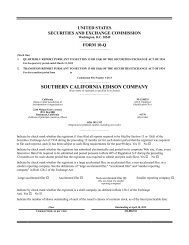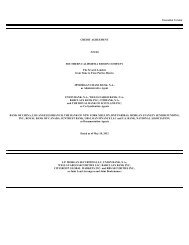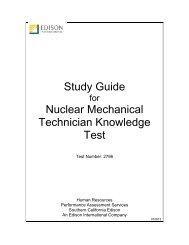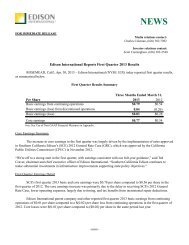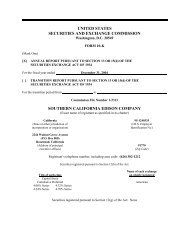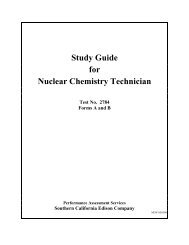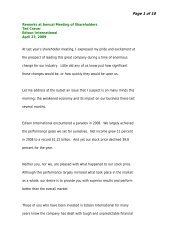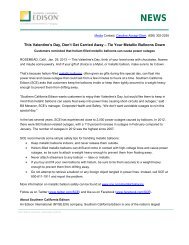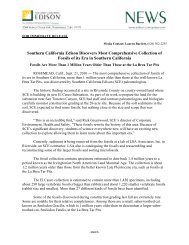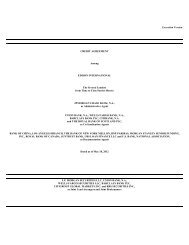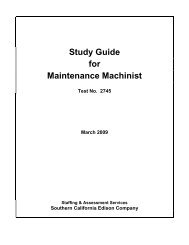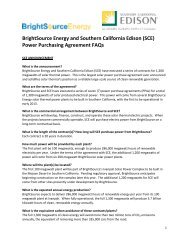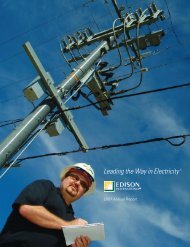San Onofre Nuclear Generating Station Design and Emergency ...
San Onofre Nuclear Generating Station Design and Emergency ...
San Onofre Nuclear Generating Station Design and Emergency ...
You also want an ePaper? Increase the reach of your titles
YUMPU automatically turns print PDFs into web optimized ePapers that Google loves.
<strong>San</strong> <strong>Onofre</strong> <strong>Nuclear</strong> <strong>Generating</strong> <strong>Station</strong> (SONGS)<br />
<strong>San</strong> <strong>Onofre</strong> <strong>Nuclear</strong> <strong>Generating</strong> <strong>Station</strong><br />
<strong>Design</strong> <strong>and</strong> <strong>Emergency</strong> Response Capability<br />
THE JAPAN NUCLEAR CRISIS – A major earthquake <strong>and</strong> subsequent tsunami damaged the reactor cooling <strong>and</strong><br />
back-up power systems at the Fukushima Daiichi <strong>Nuclear</strong> Power <strong>Station</strong> in Japan. With these systems out of operation, the fuel<br />
became overheated <strong>and</strong> the interaction between the hot fuel rods <strong>and</strong> the water resulted in the generation of hydrogen gas.<br />
The operators vented the gas from the reactor system to the surrounding secondary reactor building. The buildup of hydrogen gas from<br />
the venting led to explosions in two of the reactor buildings, damaging their structures <strong>and</strong> allowing radioactive materials to escape.<br />
DESIGN DIFFERENCES BETWEEN<br />
SAN ONOFRE AND FUKUSHIMA DAIICHI<br />
Pressurized Water vs. Boiling Water: Fukushima Daiichi<br />
uses a boiling water design, while <strong>San</strong> <strong>Onofre</strong> has<br />
pressurized water reactors. One of the key advantages of<br />
a pressurized water reactor is that it has two cooling<br />
loops, a primary <strong>and</strong> secondary, separated by steam<br />
generators. The significance of the steam generators is<br />
that water <strong>and</strong> steam from the secondary system can be<br />
vented into the atmosphere to remove heat from the<br />
nuclear fuel without releasing radioactive steam/gases<br />
because the water being vented has not been in contact<br />
with the nuclear fuel rods.<br />
Robust Containment <strong>and</strong> Tsunami Wall: <strong>San</strong> <strong>Onofre</strong> has<br />
a four- to eight-foot thick, post-tensioned, steel<br />
rebar-reinforced concrete containment that includes an<br />
internal steel liner. In addition, the <strong>San</strong> <strong>Onofre</strong> facility is<br />
protected by a tsunami wall that extends 30 feet above<br />
“mean lower low water,” the common reference point<br />
used by geophysical professionals to talk about a<br />
structure or facility's height. The most severe tsunami<br />
for SONGS was calculated after extensive studies <strong>and</strong><br />
assumes that it occurs at the same time as a high tide<br />
<strong>and</strong> storm surge, with wind driven waves.<br />
Spent Fuel Storage: At <strong>San</strong> <strong>Onofre</strong>, the spent fuel<br />
storage pools are located in a separate building adjacent<br />
to the containment structure that encloses the reactor or<br />
primary system. The used fuel rods are stored much<br />
closer to ground level than they are at Fukushima<br />
Daiichi, making it easier to add water if necessary. <strong>San</strong><br />
<strong>Onofre</strong>’s spent fuel pools are structurally robust, with<br />
hardened, steel-reinforced concrete enclosures.<br />
COMPARISON OF SEISMIC RISKS<br />
Fault Types: The earthquake fault system that generated<br />
the devastating earthquake near Honshu, Japan,<br />
originated in a subduction zone. Tsunamis that can be<br />
produced by an earthquake in a subduction zone are<br />
projected to be larger than those resulting from<br />
earthquakes in a strike-slip fault system, such as the<br />
Newport-Inglewood/Rose Canyon faults near <strong>San</strong><br />
<strong>Onofre</strong>.<br />
Richter Scale vs. Ground Movement: Much attention has<br />
been focused on the Richter scale measurements of the<br />
Japan earthquake – a 9.0 – <strong>and</strong> the implications of such a<br />
quake in California. While the Richter scale is one<br />
common way to measure the magnitude of earthquakes<br />
at their epicenters, when assessing the seismic safety at<br />
nuclear facilities, “peak ground acceleration” at the<br />
facility’s location is a more meaningful way to measure<br />
an earthquake’s potential impact, especially when the<br />
epicenter is miles away. As approved by the U.S.<br />
<strong>Nuclear</strong> Regulatory Commission, <strong>San</strong> <strong>Onofre</strong> was built<br />
to withst<strong>and</strong> a peak ground acceleration of 0.67g<br />
(g refers to the force of gravity). The maximum ground<br />
acceleration experienced at Dai-Ichi was 0.561g in a<br />
horizontal direction.<br />
For more information, please visit www.songscommunity.com.<br />
(continued on page 2)<br />
last updated on 03/07/2012<br />
SONGS13
<strong>San</strong> <strong>Onofre</strong> <strong>Nuclear</strong> <strong>Generating</strong> <strong>Station</strong> (SONGS)<br />
(continued from page 1)<br />
SAN ONOFRE BACK-UP AND SAFETY FEATURES<br />
Back-up Generators: If a power outage occurred at <strong>San</strong><br />
<strong>Onofre</strong>, a total of four emergency diesel generators on<br />
site, two per unit, each can provide approximately<br />
5,000-kilowatts of power. Each generator can be<br />
connected to provide back-up power to the other unit.<br />
The generators are located in a reinforced concrete<br />
building, separate from the containment structure that is<br />
designed to withst<strong>and</strong> earthquakes <strong>and</strong> flooding.<br />
Underground Fuel Tanks: Each generator has its own<br />
fuel oil tank located in an underground vault, <strong>and</strong> each<br />
tank provides a seven-day supply of fuel oil, which<br />
allows adequate time to obtain more fuel oil if needed.<br />
The structures that protect the generators <strong>and</strong> their fuel<br />
supply are designed to withst<strong>and</strong> earthquakes <strong>and</strong><br />
flooding.<br />
Battery Back-up: <strong>Emergency</strong> batteries <strong>and</strong> dedicated<br />
switchgear are also part of <strong>San</strong> <strong>Onofre</strong>’s design to<br />
achieve safe shutdown of the plant. They are located on<br />
upper levels inside buildings that can withst<strong>and</strong> seismic<br />
events <strong>and</strong> flooding.<br />
Redundant Cooling: To provide redundant cooling for<br />
each unit, two separate lines of safety systems are<br />
available. In addition, a steam-driven cooling pump is<br />
available to operate without electrical power, using the<br />
steam generated by the reactor to circulate cooling<br />
water.<br />
Firefighting: <strong>San</strong> <strong>Onofre</strong> has its own on-site,<br />
professional firefighting crew, with mutual aid<br />
agreements with nearby fire departments.<br />
EMERGENCY RESPONSE<br />
Coordinated Response: SCE <strong>and</strong> nearby communities<br />
have worked together since 1982 to develop <strong>and</strong><br />
continuously update a joint emergency response plan<br />
that is tested regularly for reliability <strong>and</strong> practicality. This<br />
working group includes emergency response<br />
professionals from SCE, Orange County <strong>and</strong> <strong>San</strong> Diego<br />
County, the cities of <strong>San</strong> Clemente, Dana Point, <strong>San</strong><br />
Juan Capistrano, Marine Corps Base Camp Pendleton<br />
<strong>and</strong> California State Parks. Members of this group meet<br />
monthly to ensure that coordinated plans are in place to<br />
protect public health <strong>and</strong> safety in the region<br />
surrounding the plant. The organizations routinely plan,<br />
KEY FACTS<br />
• Earthquake fault structures offshore of <strong>San</strong> <strong>Onofre</strong> are not of<br />
the type that would produce significant tsunamis. <strong>San</strong><br />
<strong>Onofre</strong>’s critical equipment is located behind a tsunami wall<br />
that is above the height of the most severe wave height.<br />
• <strong>San</strong> <strong>Onofre</strong> has robust <strong>and</strong> redundant emergency backup<br />
power capabilities, <strong>and</strong> stores approximately 4.5 million<br />
gallons of water on site that can be used for replacement<br />
cooling, even in the event of a loss of power.<br />
• Southern California Edison is committed to learning from the<br />
Fukushima accident, <strong>and</strong> is re-evaluating the capability of its<br />
equipment, procedures <strong>and</strong> training to respond to “beyond<br />
design basis” response events. We will incorporate the<br />
operating experience from the events in Japan, enhancing<br />
<strong>and</strong> further hardening the facility as needed.<br />
train <strong>and</strong> perform multiple practice drills on all aspects of<br />
the emergency program, including scenarios such as<br />
earthquakes, terrorist attacks, loss of offsite power <strong>and</strong><br />
core damage. Every two years the <strong>Nuclear</strong> Regulatory<br />
Commission <strong>and</strong> Federal <strong>Emergency</strong> Management<br />
Agency evaluate the emergency program’s preparedness<br />
through an integrated exercise.<br />
Informing the Public: In the event of an emergency, a<br />
Joint Information Center is activated to provide updates to<br />
the public to keep them informed of the plant’s status.<br />
SCE also maintains a community alert siren system, <strong>and</strong><br />
residents within the <strong>Emergency</strong> Planning Zone – a 10-mile<br />
radius surrounding <strong>San</strong> <strong>Onofre</strong> – are regularly reminded<br />
to turn on their radios or televisions for additional<br />
information in the event that an emergency siren is<br />
activated.<br />
“Beyond <strong>Design</strong> Basis” Response: In the highly unlikely<br />
case of an event larger than that for which the plant was<br />
designed were to occur, Severe Accident Management<br />
Guidelines (SAMGs) would be implemented in<br />
cooperation with emergency responders. The SAMGs<br />
work in concert with actions taken by both on-site <strong>and</strong><br />
off-site resources to protect the reactor core, containment<br />
<strong>and</strong> spent fuel pools, <strong>and</strong> to prevent radioactivity release.<br />
In addition to the SAMGs, additional procedures, operator<br />
training <strong>and</strong> equipment are in place to ensure the reactor<br />
remains cooled <strong>and</strong> covered.<br />
last updated on 03/07/2012



